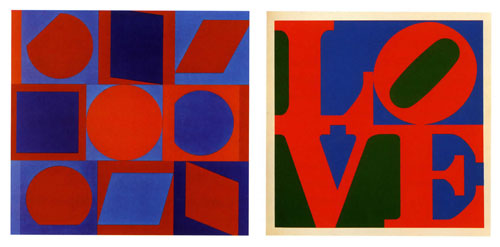The show, which as yet was untitled, opened three years later as The Responsive Eye."41
Perhaps the most significant event of 1962 took place out-of-sight in the studios of New York artists. Veteran painter Fairfieid Porter observed the happening in a letter to Robert Dash on August 21st, "I have started using liquitex, which has all that casein had for me, and then some, that is an intensity and luminosity that I never knew of before. Also it smells strangely — I recognize the smell from most New York galleries."42 Liquitex was an acrylic polymer emulsion paint first manufactured by Permanent Pigments in 1956. Water-based acrylics yielded a sharper edge and were offered in modern colors that were exceptionally intense. Anuszkiewicz, Warhol, Lichtenstein and many others switched to acrylics around 1962.
The younger artists wanted their colors to jump off the canvas. When Roy Lichtenstein says he was "looking for the most contrast. Each color had a certain character to me: the yellow was acid, and a colour that seemed to contrast as much as possible with it was a blue that was almost violet," he sounds remarkably 'optical'.43
| Victor Vasarely, Kalota, 1963, oil on canvas. St. Louis Art Museum |
 |
Robert Indiana, Love, 1967, screenprint, composition and print. New York, The Museum of Modern Art. © 2010, The Museum of Modern Art, New York/Scala, Firenze |
The major difference between artists was their sources. Pop artists, as Lichtenstein says, "would look at package labels to see what colors had the most impact on one another."44 Anuszkiewicz's approach, by contrast, was more laboratory than market research. He spent his days in the studio, mixing colors under controlled conditions, finding ways to ratchet up the power of color contrasts.
Americans 1963 was a MOMA exhibition that attempted to take stock of the re-vitalized New York scene. Curator Dorothy Miller chose "fifteen painters and sculptors of such consequence that they should, I believe, be more fully known to the Museum's public. Each has had at least one showing in New York galleries. but through this exhibition many thousands of museum visitors will see their work for the first time."45 Anuszkiewicz had five paintings in the show and garnered the lion's share of attention. Time magazine in July of 1963 devoted a feature to him with full page color illustrations of Plus Reversed and Knowledge and Disappearance (1961).
